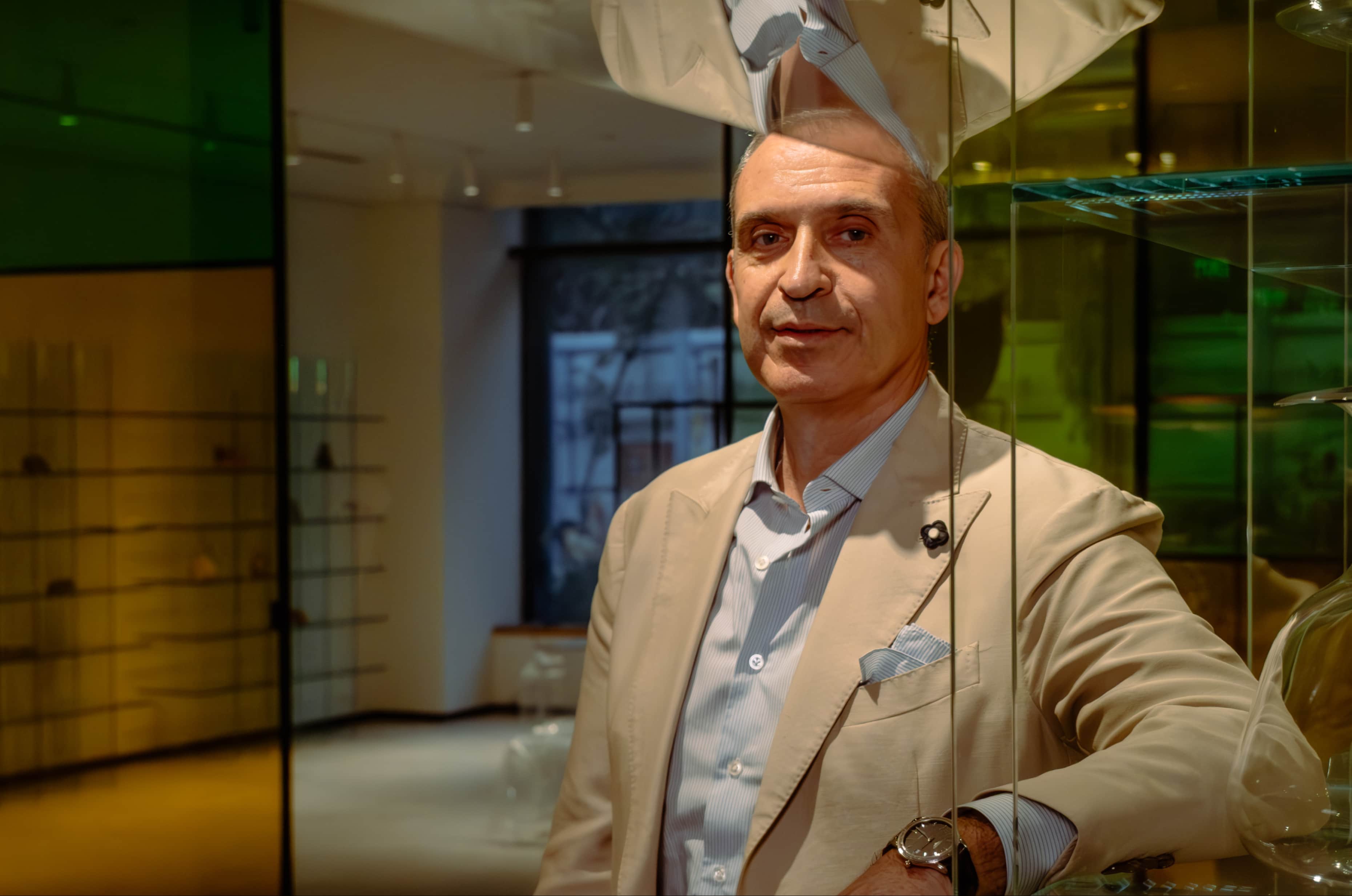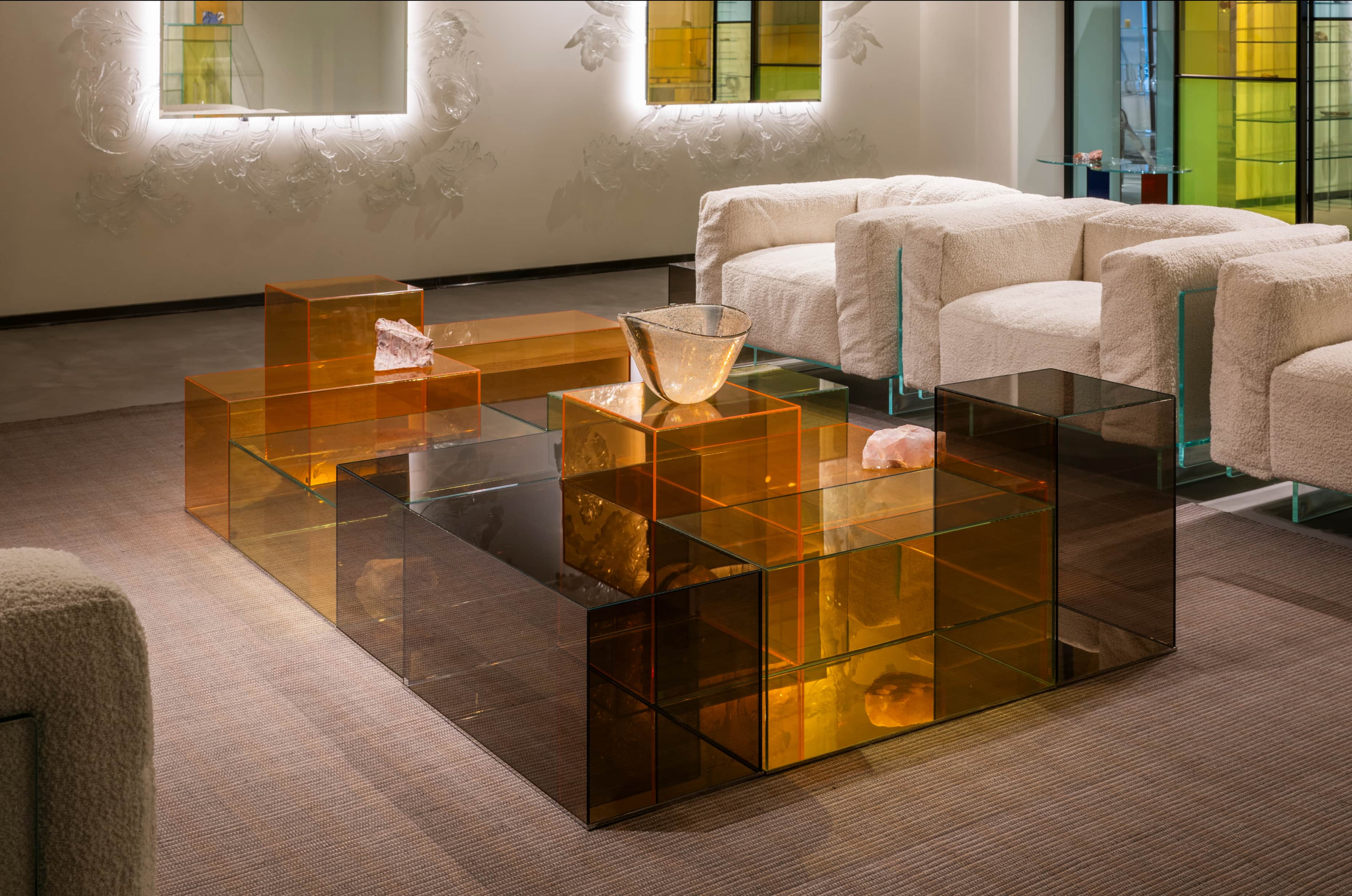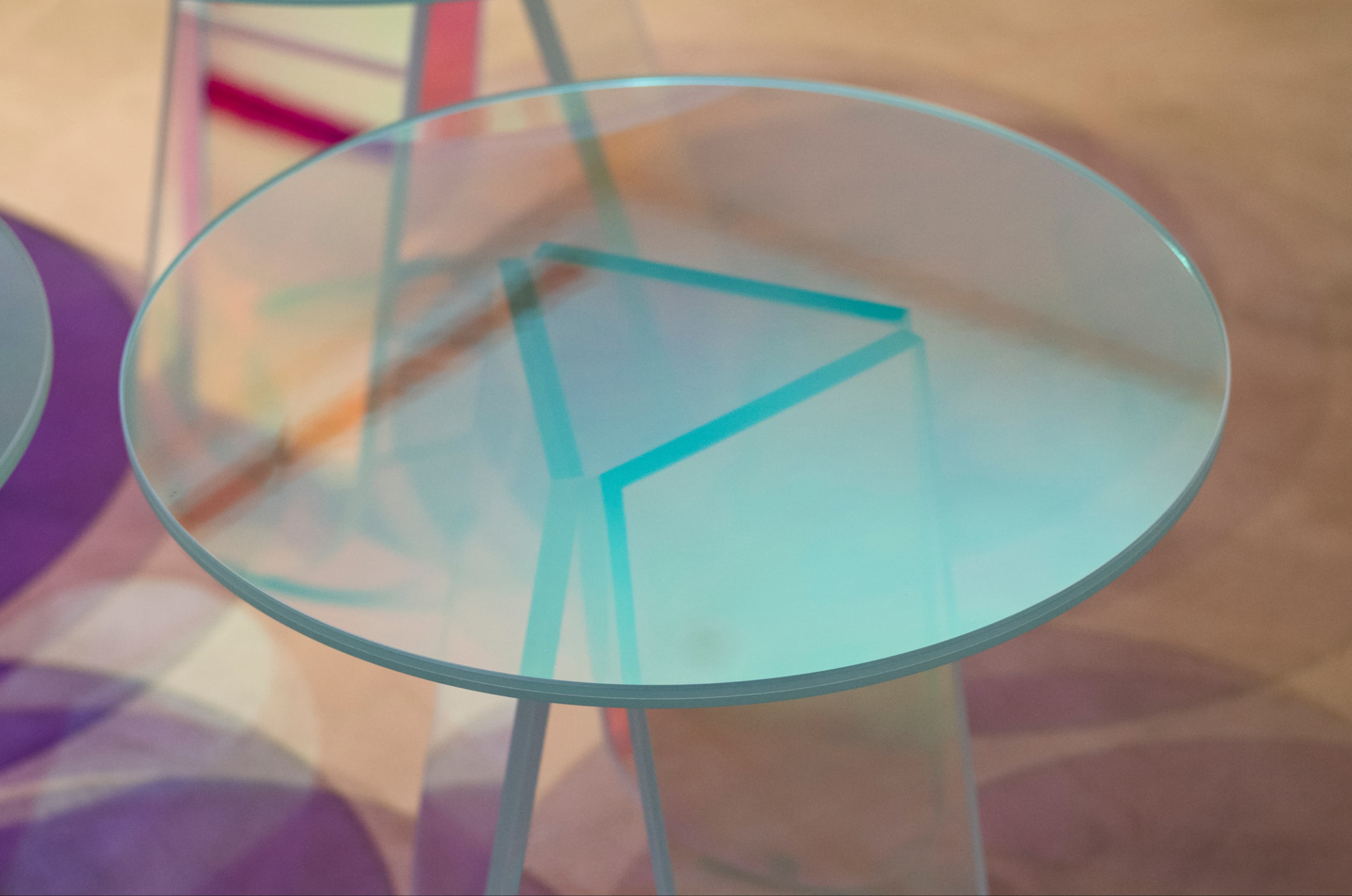
From family craftsmanship to cult collectable; a journey through two decades of Glas Italia’s iconic designs.
For as long as Italian glass has been revered, Murano has stood as its most iconic export – famed for its molten forms, vivid colours, millefiori patterns and centuries-old craftsmanship. But if Murano represents the heritage of Italian glass, Glas Italia is its modern expression. Founded in the 1970s in Brianza, the family-run company brings a design-forward approach to glass – collaborating with contemporary designers to explore its possibilities in interiors, architecture and furniture.
At their new showcase at Nilaya Anthology in Mumbai, Glas Italia presents a curated selection that’s unlike the typical showroom experience. The Sherazade Patchwork panels, designed by Piero Lissoni, feature vivid panels of laminated coloured glass arranged like a Cubist painting. The Glass Shelves by Shiro Kuramata, meanwhile, are so minimal they seem to dissolve into the air, more apparition than object.
The Shimmer Tables by Patricia Urquiola catch the light like puddles of petrol while the Liquefy collection warps it, creating surfaces that look like they’ve just been stirred. Then there are coffee tables by Philippe Starck, inspired by Donald Judd’s minimalist art, that double up as sculptural vitrines. Low-slung and clear-cut, they are designed to display and elevate objects with mirrored bases and transparent glass shells that come in twelve playful colours. It’s all brutalist geometry but with a wink.
Since the 2000s, Glas Italia has evolved from a small-scale family workshop into something of a cult favourite among contemporary architects and designers. Collaborations with visionaries like Michael Anastassiades, the Bouroullec brothers, Tokujin Yoshioka as well as design heavyweights like Jean Nouvel and studios like Yabu Pushelberg and Oki Sato’s Nendo have expanded their language into systems and structures from partition walls and integrated doorways to striking furniture.
There are legends in the mix too – Alessandro Mendini, the Milanese polymath whose work blended pop art, ornamentation and irony in the 1980s, and whose pieces for Glas Italia bring tehat same joyful provocation to life; Ettore Sottsass, the postmodern maestro whose bold, graphic mirrors are no less than museum-worthy sculptures; and Nanda Vigo, the trailblazing Italian artist and architect, whose luminous, futuristic mirrors from the 1970s were reissued by Glas Italia in 2022.
What’s striking in Mumbai is how coherent it all feels. Glas Italia’s immersive showcase at Nilaya Anthology mirrors the spirit of both their headquarters in Macherio and their acclaimed Salone del Mobile presentations – not just in aesthetics, but in ambition and scale.
We caught up with Flavio Parlato, Glas Italia’s charismatic International Sales Director, who’s on his fifth or sixth trip to India (he’s lost count, which we take as a good sign). We talk about the brand’s journey, iconic collaborations and how glass, far from being fragile, has become one of the most radical and resilient materials shaping contemporary interiors.

Nilaya Anthology (NA): Glas Italia has a storied history rooted in family craftsmanship. Can you share how this legacy influences the brand today?
Flavio Parlato (FP): Glas Italia is built on three generations of expertise in glassmaking. We formally became a brand in the 1970s but the family was active long before, since the beginning of the 20th century. In the early days, we were very much focused on artisanal pieces – pure design and art. In the early 2000s, we evolved towards industrial design, allowing us to create more complex, technically sophisticated pieces. Today, we produce doors, partitions and furniture collections with a strong design identity. Every product is treated as an opportunity for creativity in glass.
What makes Glas Italia truly special is how we use every kind of glass — from Murano glass to iridescent glass, even our innovative shimmering glass. It’s a 360-degree view of what glass can be.
NA: Your collaborations are the stuff of design legend. Which pieces still feel iconic to you?
FP: Collaborations have been central to Glas Italia’s evolution. From the “glorious age” of Italian design, there’s Ettore Sottsass and his Shiva mirror. From the international scene, there’s Shiro Kuramata and his iconic glass shelves. These two are giants – each from a different world but essential to Glas Italia’s story.
Now, we work with names like Piero Lissoni, Philippe Starck, Patricia Urquiola, Tokujin Yoshioka and Jean-Marie Massaud to name a few. You must see Lissoni’s Sherazade Patchwork Doors in coloured glass, which really gave a boost to our door systems in 2019. He also designed the Quantum bookshelves. Patricia’s Shimmer and Liquefy tables are also on view upstairs. We’ve used special films and techniques to create vibrant, shifting surfaces. There’s a thread – a fil rouge – connecting past and present, from radical icons to today’s global visionaries.

NA: What’s unique about what you’ve done here in India with Nilaya Anthology?
FP: What you see here is our latest brand identity – the most updated, integrated expression of Glas Italia. Upstairs, you’ll see systems and doors fully merged with our furniture. There’s a common language between all the elements, which is exactly what we try to show at our brand showrooms or during Salone del Mobile in Milan.
It’s not about individual pieces. It’s about how they live together and create spatial harmony. We’re very proud to present this same vision here in India. We hope visitors will leave with a new appreciation for glass as a design medium.
NA: And what’s your impression of the Nilaya Anthology, after the sneak peek?
FP: It’s majestic. There’s such good energy, in the design, yes, but also in the people. I feel like something big is happening here – not only for India but for the global design community. I truly believe this project will shift the way European or Italian design is perceived in India.
NA: Given your long association with global designers, do you see future collaborations with Indian talent?
FP: Absolutely. India is a fascinating market because of its deep appreciation for craftsmanship and its openness to new ideas. What Asian Paints is doing with Nilaya Anthology – bridging Western and Indian design cultures – is very exciting. I just had a peek at the installations by all the Indian designers downstairs and it’s clear that this space fosters collaboration. We’ve worked with many Asian designers before, especially Japanese, starting with Shiro Kuramata. I don’t think it’s a question of if, just when.

NA: So many people still think of glass as “fragile”. How have you flipped that narrative – especially with pieces like the glass sofas on display?
FP: I love this question. It’s something we want more people to understand – Glas Italia is 100% safe. We use the most advanced technologies to temper, laminate and strengthen every material we work with.
Think about it: you use glass every day. Your phone screen is glass. Your eyeglasses, windshield, drinkware – all glass. The difference is that the glass we use is toughened, engineered and tested. Even our furniture is made from tempered glass – like the sectional sofas by Jean-Marie Massaud that you’re sitting on! Remove the cushion and you can literally jump on it. The edges are rounded. It’s child-safe, pet-safe, life-safe.
NA: Speaking of the sofa, what’s the story behind that piece?
FP: It’s one of our earliest pieces. What we wanted was to use glass the way other companies use wood or metal but with a twist. Glass offers this wonderful sense of lightness. These armchairs and sofas by Jean-Marie Massaud appear to be floating in air. The back panel is also glass, curved and softened at the edges. The effect is elegant but the material strength is undeniable too.
NA: Finally, a personal question: after so many visits to India, what do you make sure to take home?
FP: Always something beautiful. I’m searching for authentic Himalayan pashminas this time. I bought a few about ten years ago and they’re still so beautiful. Also incense because my wife loves it. I can't go home empty-handed!